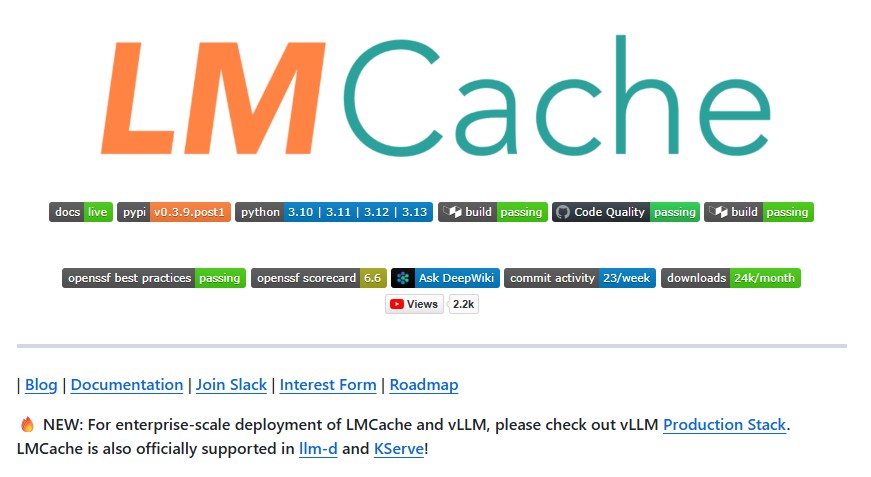As large language models (LLMs) continue to scale in size and complexity, organizations face an increasingly critical challenge: serving models efficiently in real-world applications. While LLM capabilities are rapidly evolving, the bottleneck of inference performance remains a major limitation especially when dealing with long-context workloads or high-traffic enterprise environments.
This is where LMCache steps in. LMCache is an advanced extension for LLM serving engines designed to drastically reduce Time To First Token (TTFT) and boost throughput particularly for long-context and multi-round conversational use cases. It offers a new paradigm in LLM acceleration by leveraging reusable Key-Value (KV) caches stored across multiple memory tiers including GPU, CPU DRAM and local disk. By reusing cached tokens across inputs and requests, LMCache dramatically reduces the computational burden on GPUs, enabling faster response times and significantly lower serving costs.

Today, LMCache integrates deeply with vLLM and SGLang and is being adopted in real-world enterprise deployments. In this blog, we explore how LMCache works, its key features, practical use cases and why it is rapidly becoming a foundational technology for efficient LLM inference.
What is LMCache?
It is a specialized KV cache layer designed for LLM inference optimization. Traditionally, each request in an LLM pipeline requires recomputing key-value attention caches even when large portions of input text repeat. As usage patterns like RAG pipelines, chat applications, and enterprise assistants increasingly rely on overlapping content, the inefficiencies of recomputing become highly visible and expensive.
It resolves this by caching and reusing previously computed KV values across request sessions and even across model instances. This enables faster token generation and lower GPU utilization while maintaining high accuracy and compatibility with modern LLM architectures.
In combination with vLLM, LMCache delivers between 3x and 10x performance gains for many production scenarios, particularly multi-turn dialogue and retrieval-augmented generation pipelines.
Key Features of LMCache
Advanced KV Cache Storage
It supports hierarchical storage layers, including:
- GPU memory for ultra-fast access
- CPU DRAM for cost-efficient mid-tier caching
- Local disk and NIXL for large persistent storage
This multi-tier caching approach enables a scalable and balanced memory strategy, allowing organizations to optimize for latency and cost.
Integration With Leading LLM Serving Engines
It integrates seamlessly with leading inference platforms:
- vLLM v1 full integration
- SGLang cache offloading support
- Supported within vLLM Production Stack, llm-d, and KServe
This makes LMCache particularly attractive for enterprises already adopting modern LLM serving frameworks.
High-Performance Techniques
It enables key capabilities such as:
- High-performance CPU KV cache offloading
- Disaggregated prefill execution
- Peer-to-peer (P2P) KV cache sharing
- Stable non-prefix KV caching for maximum cache hit flexibility
In simple terms, It allows reuse of both prefix and non-prefix segments across diverse workloads extending the caching paradigm beyond simple prompt matching.
Installation and Deployment
It is available via pip and works on NVIDIA GPU Linux environments:
pip install lmcache
It also supports advanced deployment environments, including enterprise clusters with custom vLLM builds and distributed inference workflows.
Why LMCache Matters for Modern AI Applications
Solving the TTFT Bottleneck
LMCache reduces Time To First Token by avoiding redundant compute especially for repetitive input segments such as conversation history, RAG documents, or recurring instructions. This improvement is critical for customer-facing AI products where latency directly affects user experience.
Lowering GPU Costs
By reducing computation demand, LMCache enables:
- Fewer required GPU cycles
- Increased request throughput per GPU
- Maximized utilization of existing hardware
This leads to significant cost savings for companies deploying large-scale AI services.
Powering Long-Context Workflows
As context windows scale into hundreds of thousands of tokens, caching becomes essential. LMCache ensures long-context usage remains economically viable and performant positioning it for the future of long-context LLMs.
Use Cases
LMCache excels in scenarios like:
- Multi-round conversational AI
- Retrieval-Augmented Generation (RAG)
- Agentic pipelines with repeated instructions or tools usage
- Customer support and enterprise chatbots
- Research applications requiring repeated context analysis
- Distributed inference clusters serving repeated prompts
In each case, efficient KV caching minimizes latency and improves scalability.
Getting Started
To begin experimenting, developers can leverage the official LMCache documentation, quickstart examples and actively maintained community resources. The project maintains detailed guides for resolving dependency mismatches and integrating with vLLM versions.
Active community support via Slack, regular community calls and ongoing academic research ensure LMCache evolves rapidly with the LLM ecosystem.
Conclusion
LMCache represents a major breakthrough in efficient LLM serving. By enabling reusable KV caching across multi-tier storage and integrating seamlessly with modern inference engines like vLLM and SGLang, it dramatically reduces TTFT, improves throughput and optimizes compute costs for large-scale deployments.
As AI applications grow and long-context workloads become the norm, LMCache is poised to become a foundational layer for enterprise-grade LLM acceleration. Whether you are building conversational AI, RAG platforms or scalable inference clusters, LMCache delivers unmatched performance benefits and future-ready efficiency.
Follow us for cutting-edge updates in AI & explore the world of LLMs, deep learning, NLP and AI agents with us.
Related Reads
- Chandra OCR: The Future of Document Understanding and Layout-Aware Text Extraction
- Pixeltable: The Future of Declarative Data Infrastructure for Multimodal AI Workloads
- Meilisearch: The Lightning-Fast, AI-Ready Search Engine for Modern Applications
- Kimi Linear: The Future of Efficient Attention in Large Language Models
- FIBO: The First JSON-Native, Open-Source Text-to-Image Model Built for Real-World Control and Accuracy

2 thoughts on “LMCache: Accelerating LLM Inference With Next-Generation KV Cache Technology”